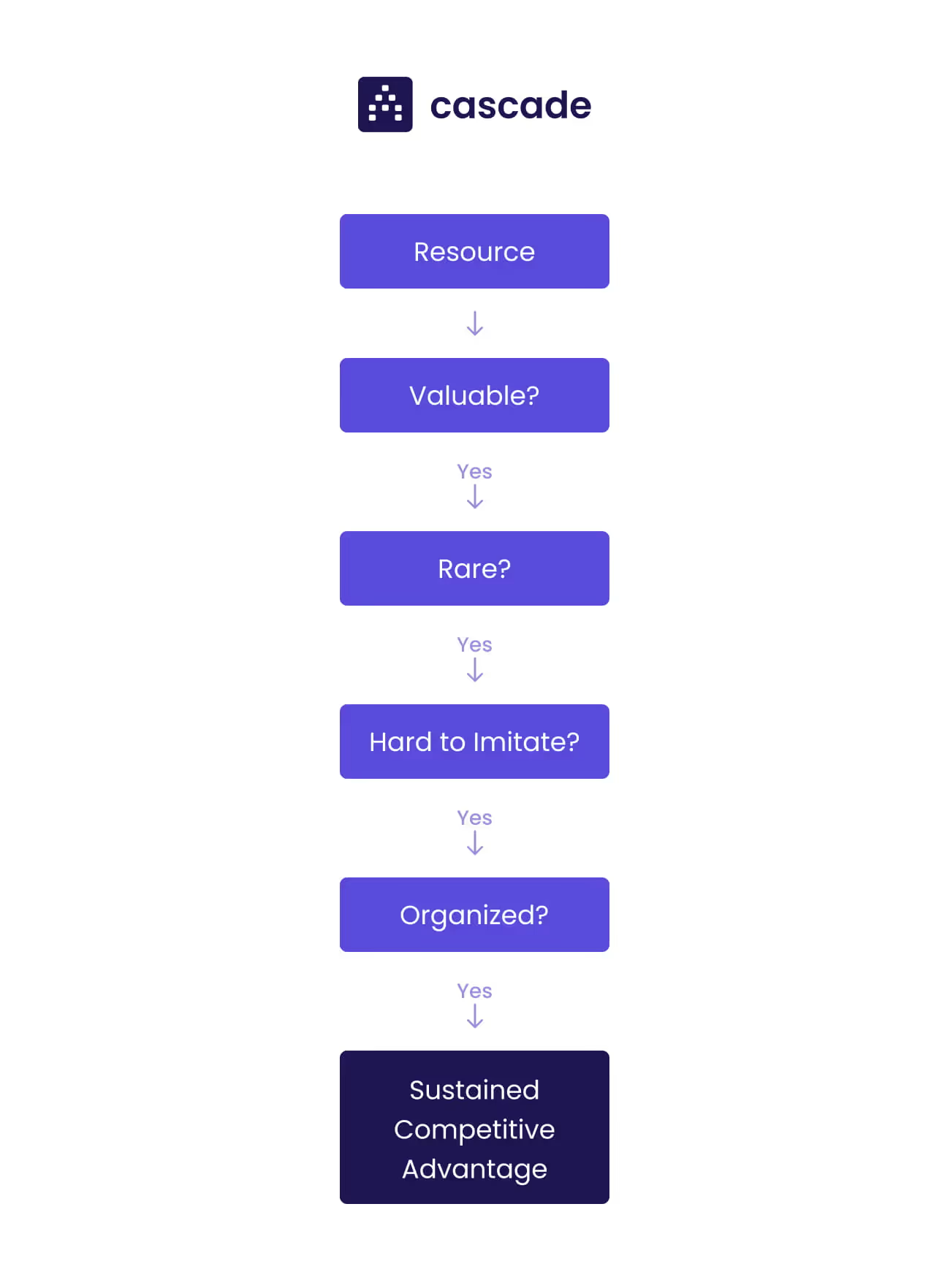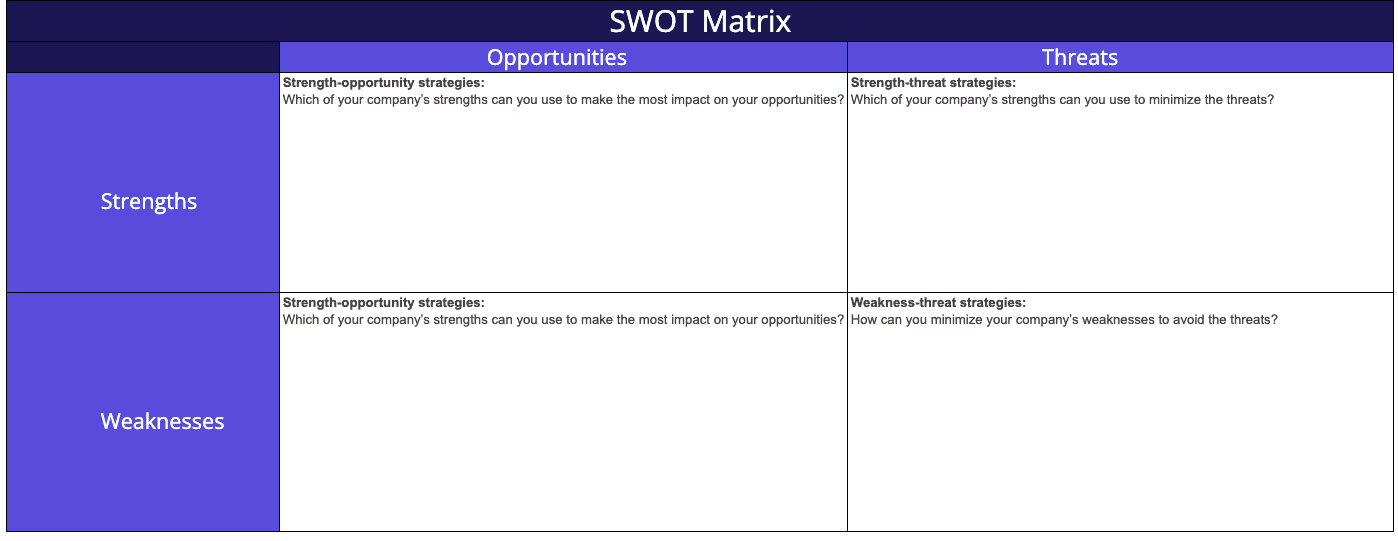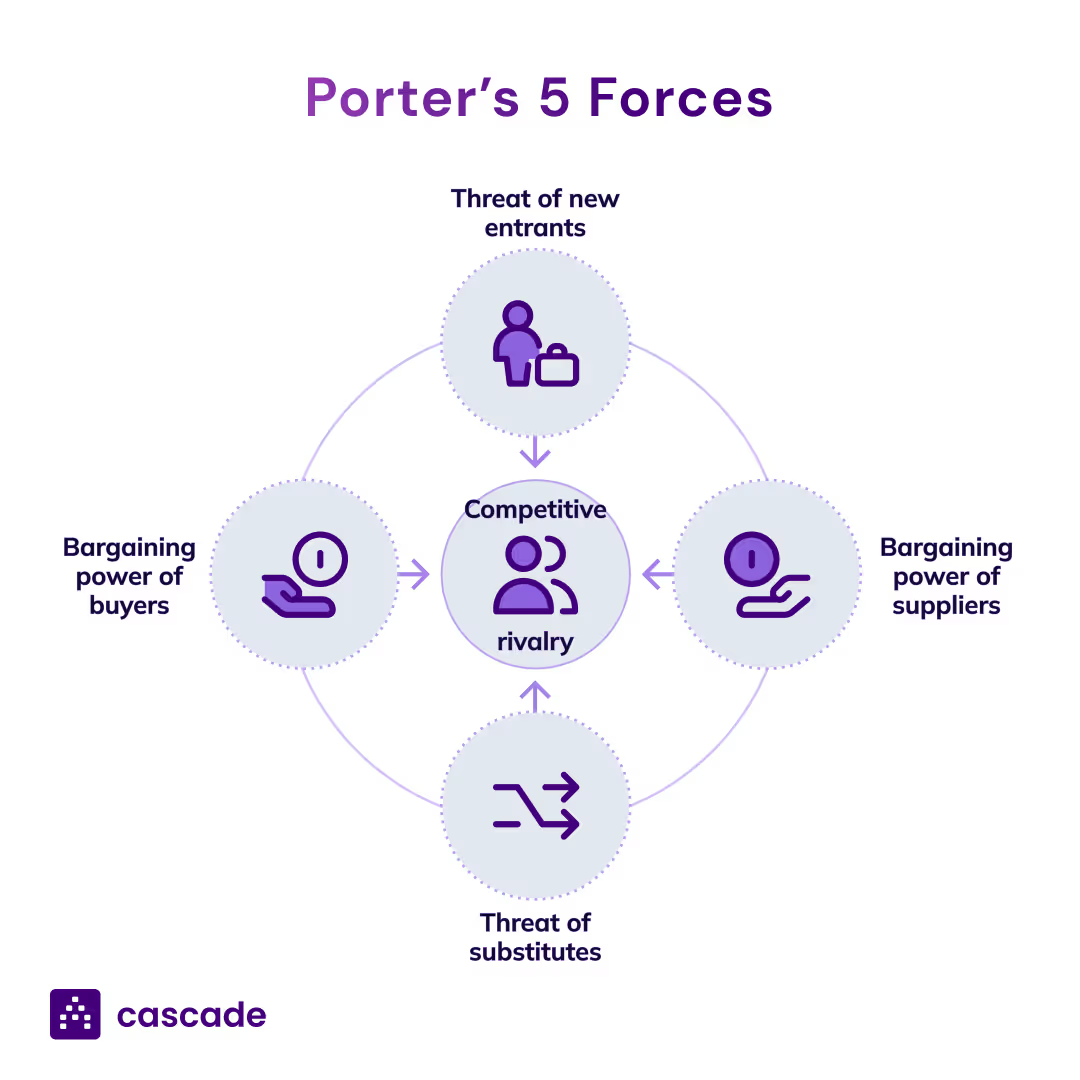A huge part of developing a strategic plan is a reliable, in-depth strategic analysis. An organization is separated into internal and external environments. Both components should be scrutinized to identify factors influencing organizations and guiding decision-making.
In this article, we'll cover:
- What Is Strategic Analysis?
- Types Of Strategic Analysis
- Benefits Of Strategic Analysis For Strategy Formulation
- Strategic Analysis Example - Walmart
- How To Do A Strategic Analysis: Key Components
- Strategic Analysis Tools
- How To Choose The Right Strategic Analysis Tool
- The Next Step: From Analysis To Action With Cascade 🚀
⚠️ Remember, insights aren't enough! Understanding your internal & external environment is vital, but true strategy comes from action. Cascade Strategy Execution Platform bridges the gap between analysis and execution. Talk to our strategy experts to turn your strategic analysis into a winning business strategy with clear goals and measurable results.
What Is Strategic Analysis?
Strategic analysis is the process of researching and analyzing an organization along with the business environment in which it operates to formulate an effective strategy. This process of strategy analysis usually includes defining the internal and external environments, evaluating identified data, and utilizing strategic analysis tools.
By conducting strategic analysis, companies can gain valuable insights into what's working well and what areas need improvement. These valuable insights become key inputs for the strategic planning process, helping businesses make well-informed decisions to thrive and grow.
Types Of Strategic Analysis
When it comes to strategic analysis, businesses employ different approaches to gain insights into the internal and external factors influencing their operations.
Let's explore two key types of strategic analysis:
Internal strategic analysis
The focus of internal strategic analysis is on diving deep into the organization's core. It involves a careful examination of the company's strengths, weaknesses, resources, and competencies. By conducting a thorough assessment of these aspects, businesses can pinpoint areas of competitive advantage, identify potential bottlenecks, and uncover opportunities for improvement.
This introspective analysis acts as a mirror, reflecting the organization's current standing, and provides valuable insights to shape the path that will ultimately lead to achieving its mission statement.
External strategic analysis
On the other hand, external strategic analysis zooms out to consider the broader business environment. This entails conducting market analysis, trend research, and understanding customer behaviors, regulatory changes, technological advancements, and competitive forces. By understanding these external dynamics, organizations can anticipate potential threats and uncover opportunities that can significantly impact their strategic decision-making.
The external strategic analysis acts as a window, offering a view of the ever-changing business landscape.
Benefits Of Strategic Analysis For Strategic Planning
The analysis phase sets “the stage” for your strategic planning.
The strategic analysis informs the activities you undertake in strategic formulation and allows you to make informed decisions. This phase not only sets the stage for the development of effective business planning but also plays a crucial role in accurately framing the challenges to be addressed.
These are some benefits of strategic analysis for strategic planning:
- Holistic view: Gain a comprehensive understanding of internal capabilities, the external landscape, and potential opportunities and threats.
- Accurate challenge framing: Identify and define core challenges accurately, shaping the strategy development process.
- Proactive adaptation: Anticipate potential bottlenecks and areas for improvement, fostering proactive adaptability.
- Leveraging strengths: Develop strategies that maximize organizational strengths for a competitive advantage.
Strategic Analysis Example - Walmart
At the very least, the right framing can improve your understanding of your competitors and, at its best, revolutionize an industry. For example, everybody thought that the early success of Walmart was due to Sam Walton breaking the conventional wisdom:
“A full-line discount store needs a population base of at least 100,000.”
But that's not true.
Sam Walton didn't break that rule, he redefined the idea of the “store,” replacing it with that of a “network of stores.” That led to reframing conventional wisdom, developing a coherent strategy, and revolutionizing an industry.
👉🏻 Check out our #StrategyStudy: How Walmart Became The Retailer Of The People
How To Do A Strategic Analysis: Key Components
%2520(1).avif)
Strategy is not a linear process.
Strategy is an iterative process where strategic planning and execution interact with each other constantly.
First, you plan your strategy, and then you implement it and constantly monitor it. Tracking the progress of your and KPIs (key performance indicators) allows you to identify what's working and what needs to change. This feedback loop guides you to reassess and readjust your strategic plan before proceeding to implementation again. This iterative approach ensures adaptability and enhances the strategy's effectiveness in achieving your goals.
Strategic planning includes the strategic analysis process.
The content of your strategic analysis varies, depending on the strategy level at which you're completing the strategic analysis for.
For example, a team involved in undertaking a strategic analysis for a corporation with multiple businesses will focus on different things compared to a team within a department of an organization.
But no matter the team or organization's nature, whether it's a supply chain company aiming to enhance its operations or a marketing team at a retail company fine-tuning its marketing strategy, conducting a strategic analysis built on key components establishes a strong foundation for well-informed and effective decision-making.
The key components of strategic analysis are:
- Define the strategy level for the analysis
- Complete an internal analysis
- Complete an external analysis
- Unify perspectives & communicate insights
%2520(1).avif)
Define the strategy level for the analysis
Strategy comes in different levels depending on where you are in an organization and your organization's size.
You may be creating a strategy to guide the direction of an entire organization with multiple businesses, or you may be creating a strategy for your marketing team. As such, the process will differ for each level as there are different objectives and needs.
The three strategy levels are:
👉🏻 If you're not sure which strategy level you're completing your strategy analysis for, read this article explaining each of the strategy levels.
Conduct an internal analysis
As we mentioned earlier, an internal analysis looks inwards at the organization and assesses the elements that make up the internal environment. Performing an internal analysis allows you to identify the strengths and weaknesses of your organization.
Let's take a look at the steps involved in completing an internal analysis:
1. Assessment of tools to use
First, you need to decide what tool or framework you will use to conduct the analysis.
You can use many tools to assist you during an internal analysis. We delve into that a bit later in the article, but to give you an idea, for now, Gap Analysis, Strategy Evaluation, McKinsey 7S Model, and VRIO are all great analysis techniques that can be used to gain a clear picture of your internal environment.
2. Research and collect information
Now it's time to move into research. Once you've selected the tool (or tools) you will use, you will start researching and collecting data.
The framework you use should give you some structure around what information and data you should look at and how to draw conclusions.
3. Analyze information
The third step is to process the collected information. After the data research and collection stage, you'll need to start analyzing the data and information you've gathered.
How will the data and information you've gathered have an impact on your business or a potential impact on your business? Looking at different scenarios will help you pull out possible impacts.
4. Communicate key findings
The final step is sharing your conclusions. What is the value of your analysis' conclusions if nobody knows about them?
You should be communicating your findings to the rest of the team involved in the analysis and go even further. Share relevant information with the rest of your people to demonstrate that you trust them and offer context to your decisions.
Once the internal analysis is complete, you should have a clear idea of where your organization is excelling, where you're doing OK, and where current deficits and gaps lie.
The analysis provides your leadership team with valuable insights to capitalize on strengths and opportunities effectively. It also empowers them to devise strategies that address potential threats and counteract identified weaknesses.
Beginning strategy formulation after this analysis will ensure your strategic plan has been crafted to take advantage of strengths and opportunities and offset or improve weaknesses & threats. This way, the strategic management process remains focused on the identified priorities, enabling a well-informed and proactive approach to achieving your organizational goals.
You can then be confident that you're funneling your resources, time, and focus effectively and efficiently.
Conduct an external analysis
As we stated before, the other type of strategic analysis is the external analysis which looks at an organization's environment and how those environmental factors currently impact or could impact your organization.
A key difference between the external and the internal factors lies in the organization's level of control.
Internally, your organization wields complete control and can actively influence these factors. On the other hand, external components lie beyond the organization's direct control, and the focus is on scanning and reacting to the environment rather than influencing it.
External factors of your organization include the industry the organization competes in, the political and legal landscape the organization operates in, and the communities they operate in.
The steps for conducting this analysis are much the same as an internal analysis:
- Assessment of tools to use
- Research and collect information
- Analyze information
- Communicate key findings
You'll want to use a tool such as SWOT analysis, PESTLE analysis, or Porter's Five Forces to help you add some structure to your analysis. We'll dive into the tools in more detail further down this article!
Unify perspectives & communicate insights
Chances are, you didn't tackle the entire analysis alone. Different team members likely took responsibility for specific parts, such as the internal gap analysis or external environmental scan. Each member contributed valuable insights, forming a mosaic of information.
To ensure a comprehensive understanding, gather feedback from all team members involved. Collate all the data and share the complete picture with relevant stakeholders across your organization.
Much like strategy, this information is useless if not shared with everyone.
Remember: There is no such thing as overcommunication.
If you have to keep only one rule of communication, it's that one. Acting on the insights and discoveries distilled from the analysis is what gives them value. Communicating those findings with your employees and all relevant (internal and external) stakeholders enables acting on them.
Setting up a central location where everyone can access the data should be your first step, but it shouldn't end there. Organize a meeting to go through all the key findings and ensure everyone is on the same page regarding the organization's environment.
Strategic Analysis Tools
There are a number of strategic analysis tools at your disposal. We'll show you 8 of the best strategic analysis tools out there.
.avif)
The 8 best strategic analysis tools:
- Gap Analysis
- VRIO Analysis
- Four Corners Analysis
- Value Chain Analysis
- SWOT Analysis
- Strategy Evaluation
- Porter's Five Forces
- PESTEL Analysis
Note: Analytical tools rely on historical data and prior situations to infer future assumptions. With this in mind, caution should always be used when making assumptions based on your strategic analysis findings.
Gap Analysis
%2520(1).avif)
The Gap Analysis is a great internal analysis tool that helps you identify the gaps in your organization, impeding your progress towards your objectives and vision.
The analysis gives you a process for comparing your organization's current state to its desired future state to draw out the current gaps, which you can then create a series of actions that will bridge the identified gap.
The gap analysis approach to strategic planning is one of the best ways to start thinking about your goals in a structured and meaningful way and focuses on improving a specific process.
👉 Grab your free Gap Analysis template to streamline the process!
.avif)
VRIO Analysis

The VRIO Analysis is an internal analysis tool for evaluating your resources.
It identifies organizational resources that may potentially create sustainable competitive advantages for the organization. This analysis framework gives you a process for categorizing the resources in your organization based on whether they hold certain traits: Valuable, Rare, Inimitable, and Organized.
The framework then encourages you to begin thinking about moving those resources to the “next step'' to ultimately develop those resources into competitive advantages.
👉 Grab your free VRIO strategy template that will help you to develop and execute a strategy based on your VRIO analysis.
Four Corners Analysis
.avif)
The Four Corners Analysis framework is another internal analysis tool that focuses on your organization's core competencies.
However, what differentiates this tool from the others is its long-term focus. To clarify, most of the other tools evaluate the current state of an entity, but the Four Corners Analysis assesses the company's future strategy, which is more precise because it makes the corporation one step ahead of its competitors.
By using the Four Corners, you will know your competitors' motivation and their current strategies powered by their capabilities. This analysis will aid you in formulating the company's trend or predictive course of action.
Value Chain Analysis
.avif)
Similar to VRIO, the Value Chain Analysis is a great tool to identify and help establish a competitive advantage for your organization.
The Value Chain framework achieves this by examining the range of activities in the business to understand the value each brings to the final product or service.
The concept of this strategy tool is that each activity should directly or indirectly add value to the final product or service. If you are operating efficiently, you should be able to charge more than the total cost of adding that value.
SWOT
.avif)
A SWOT analysis is a simple yet ridiculously effective way of conducting a strategic analysis.
It covers both the internal and external perspectives of a business.
When using SWOT analysis, one thing to keep in mind is the importance of using specific and verifiable statements. Otherwise, you won't be able to use that information to inform strategic decisions.
👉 Grab your free SWOT Analysis template to streamline the process!

Strategy Evaluation
Generally, every company will have a previous strategy that needs to be taken into consideration during a strategic analysis.
Unless you're a brand new start-up, there will be some form of strategy in the company, whether explicit or implicit. This is where a strategy evaluation comes into play.
The previous strategy shouldn't be disregarded or abandoned, even if you feel like it wasn't the right direction or course of action. Analyzing why a certain direction or course of action was decided upon will inform your choice of direction.
A Strategic Evaluation looks into the strategy previously or currently implemented throughout the organization and identifies what went well, what didn't go so well, what should not have been there, and what could be improved upon.
👉To learn more about this analysis technique, read our detailed guide on how to conduct a comprehensive Strategy Evaluation.
Porter's Five Forces

Complementing an internal analysis should always be an analysis of the external environment, and Porter's Five Forces is a great tool to help you achieve this.
Porter's Five Forces framework performs an external scan and helps you get a picture of the current market your organization is playing in by answering questions such as:
- Why does my industry look the way it does today?
- What forces beyond competition shape my industry?
- How can I find a position among my competitors that ensures profitability?
- What strategies can I implement to make this position challenging for them to replicate?
With the answer to the above questions, you'll be able to start drafting a strategy to ensure your organization can find a profitable position in the industry.
👉 Grab your free Porter's 5 Forces template to implement this framework!

PESTLE Analysis

We might sound repetitive, but external analysis tools are critical to your strategic analysis.
The environment your organization operates in will heavily impact your organization's success. PESTLE analysis is one of the best external analysis tools you can use due to its broad nature.
The name PESTLE is an acronym for the elements that make up the framework:
- Political
- Economic
- Social
- Technological
- Legal
- Environmental
Basically, the premise of the analysis is to scan each of the elements above to understand the current status and how they can potentially impact your industry and, thus, your organization.
PESTLE analysis gives you extra focus on certain elements that may have a wide-ranging impact, and a birds-eye view of the macro-environmental factors.
How To Choose The Right Strategy Analysis Tools
There are as many ways to do strategy as there are organizations. So not every tool is appropriate for every organization.
These 8 tools are our top picks for giving you a helping hand through your strategic analysis. They're by no means the whole spectrum. There are many other frameworks and tools out there that could be useful and provide value to your process.
Choose the tools that fit best with your approach to doing strategy. Don't limit yourself to one tool if it doesn't make sense, don't be afraid to combine them, mix and match! And, be faithful to each framework but always as long as it fits your organization's needs.
The Next Step: From Analysis To Action With Cascade 🚀
Completing the strategic analysis phase is a crucial milestone, but it's only the beginning of a successful journey. Now comes the vital task of crafting your strategic plan and ensuring its effective execution. This is where comes into play, offering a powerful solution to drive your strategy forward.
Cascade is your ultimate partner in strategy execution. With its user-friendly interface and robust features, it empowers you to translate the strategic insights distilled from your strategic analysis into actionable plans.
Some key features include:
- Planner: Seamlessly build out your objectives, initiatives, and key performance indicators (KPIs) while aligning them with the organization's goals. Break down the complexity from high-level initiative to executable outcomes.
- Alignment Map: Visualize how different organizational plans work together and how your corporate strategy breaks down into operational and functional plans.
%2520(1).avif)
- Metrics & Measures: Connect your business data directly to your core initiatives in Cascade for clear data-driven alignment.
.avif)
- Integrations: Consolidate your business systems underneath a unified roof. Import context in real-time by leveraging Cascade's native, third-party connector (Zapier/PA), and custom integrations.
- Dashboards & Reports: Stay informed about your strategy's performance at every stage with Cascade's real-time tracking and progress monitoring, and share it with your stakeholders, suppliers, and contractors.
Experience the power of Cascade today! Sign up today for a free forever plan book a guided 1:1 tour with one of our Cascade in-house strategy execution experts.


.avif)




.png)
.jpg)
.jpg)
%20(1)%20(1)%20(1)%20(1)%20(1).png)



